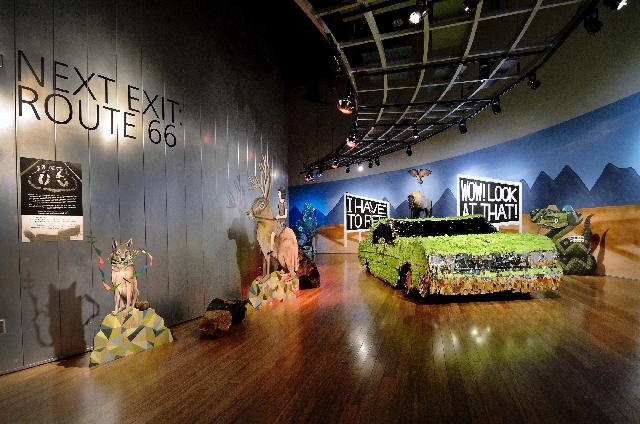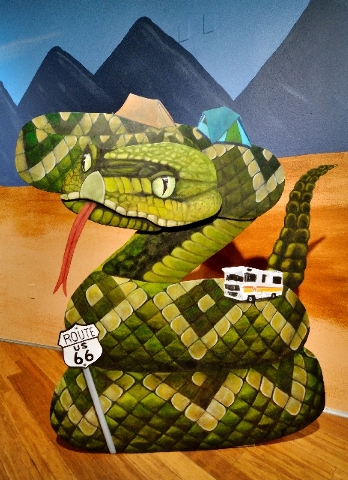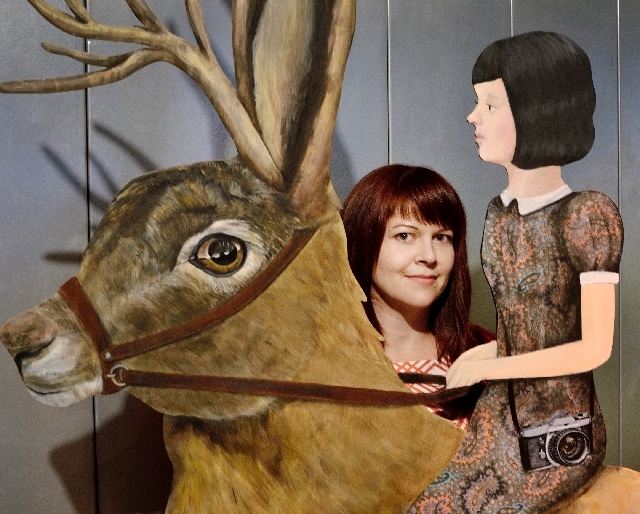Local artists explore famous highway’s mystique in ‘Next Exit: Route 66’
OK, everybody into the car! It’s time to hit the road.
The Mother Road, that is — better known as Route 66, the eight-state highway that, in the pre-interstate era, linked America’s heartland with the wilds of the Southwest.
This particular road trip, however, doesn’t require a literal drive to such Route 66 outposts as Kingman, Ariz., or Barstow, Calif.
It’s as close as the Springs Preserve’s Big Springs Gallery, where five local artists explore the legendary highway’s mystique in “Next Exit: Route 66.”
Echoing generations of families who shared on-the-road adventures, the artists involved in the “Next Exit” exhibit made the journey together.
“We’ve been having meetings and bouncing around ideas for several months,” says JW Caldwell, whose painted acrylic backdrop for his fellow artists’ work comes complete with a fanciful, storybook-style landscape.
To say nothing of roadside signs asking such quintessential questions as “Wow! Look at that!” and the inevitable “Are We There Yet?”
Although “everyone did their own thing, we all fed off the energy of each other,” Caldwell says. “The show came together much more cohesively,” with artists attending pre-show meetings armed with “sketches on cocktail napkins” to get feedback from their fellow artists.
Sometimes that feedback made a decisive difference in the finished product.
Just ask artist Justin Favela, whose giant pinata depiction of a 1964 Chevrolet Impala sedan captures a low-rider classic in all its macho glory.
The cardboard-and-tissue-paper car continues Favela’s interest in making fine-art pinatas inspired by “stereotypical Latino objects,” he says.
But he couldn’t decide what color his full-size Impala pinata should be. Gold, like the low-rider Impala featured in “Boyz N the Hood”? Or orange, as he recalled from the comedy “Friday”?
When Favela mentioned lime green to his fellow artists, however, “their eyes lit up,” he notes, explaining how his Impala — 7½ feet long and 6½ feet wide — came to be covered with lime-green tissue paper.
“I’ve never been part of a show where we sat down and talked about our ideas,” Favela says. “It was great, just to kind of feed off of everyone’s ideas.”
The collaborative process illustrates how “different languages” help “to make a new voice,” says artist Su Limbert. “I love seeing the styles mesh.”
Limbert’s “Next Exit” contribution: a quirky cast of plywood-and-masonite wildlife characters, from a giant jackalope transporting a camera-toting girl to a coyote clutching flowers in his teeth.
Limbert describes her Route 66 creatures as “Mother Nature meets the Mother Road,” embodying the contrast between the desert’s natural inhabitants and the road’s human additions, from motels and RVs to the giant dinosaur depicted in Todd Duane Miller’s hand-painted photo.
Miller’s collage of images features the massive Tyrannosaurus rex (towering over the World’s Biggest Dinosaurs Gift Store in Cabazon, Calif., west of Palm Springs) and a historic vehicle license plate from a 1954 Chevy panel truck Miller bought in Prescott Valley, Ariz.
An accompanying video (titled “One Man’s Trash ...”) recounts the results of Miller’s desert wanderings, looking for “whatever caught my eye.”
Among the things that did: a refrigerator door lying on the desert floor to a deserted building’s weatherbeaten wall, with a heart painted on it, along with the inscription, “This is beautiful.”
In describing his Route 66 quest, Miller quotes Oscar-winning “Rain Man” director Barry Levinson, noting that “the interstates look like everywhere else — and to feel like you’re getting somewhere, you have to get to the two-lane blacktop.”
The “two-lane blacktop” that became Route 66 was one of the first nationally designated highways when it was approved in 1926, winding (as Bobby Troup’s 1946 song “Get Your Kicks” would note) from Chicago to L.A.
From John Steinbeck’s “The Grapes of Wrath” to Jack Kerouac’s “On the Road,” from the 1960s TV series “Route 66” to the 2006 animated hit “Cars” (which in turn inspired the new Cars Land at Disney’s California Adventure), Route 66 “holds a firm place in our national subconscious,” according to Jessica Hougen, assistant curator at the Springs Preserve.
Which is exactly what inspired the exhibit, she says.
Last fall, Hougen “was talking with JW (Caldwell) about a bunch of stuff, and he was talking with Justin Favela, who wanted to do a full-size car” as his next fine-art pinata, she remembers.
That — and a travel article about “a great fall road trip” — prompted the choice of Route 66 as “Next Exit’s” focus.
Hougen contacted artists “whose work I knew would work well” and brought them together for an initial meeting, when they “kicked around ideas,” deciding “who wanted to do what.”
Hougen “should get some pats on the back for this,” Limbert says, especially for “pinpointing key artists who could contribute.”
Memories of family road trips — and her late grandfather, who told Limbert about his own Route 66 adventure in his younger days — sparked her interest in the project.
For artist Andreana Donahue, who carved the exhibit’s “rocks” from cardboard and paper, “I liked some of the geological formations in the desert” — especially those in Arizona’s Petrified Forest, another Route 66 attraction.
Additionally, Donahue’s interest in science fiction movies filmed in Route 66 territory resulted in a cardboard emergency call box that’s “not supposed to look realistic,” she says. “It’s ambiguous; you don’t know what it is.”
Caldwell, who hails from the California desert town of Banning, down the road from Cabazon, grew up “surrounded by car culture,” making road trips a tradition.
Favela, a Las Vegas native, also remembers traveling Route 66 territory “mostly when I was a kid, seeing that expanse of desert.”
But Miller, who grew up in the Midwest, experienced a different Route 66, characterized by “oak tree-lined roads and Main Street USA,” rather than the Southwest’s “wide-open vistas and barren landscape.”
Yet there’s plenty of diversity in that seemingly barren landscape, Miller adds.
“You can learn about the country” by looking out the car window and watching it roll by, he suggests, “if you’ve got the time to look.”
And if you don’t, there’s always “No Exit,” which follows a different Route 66: the one that runs through the imagination.
Contact reporter Carol Cling at ccling@
reviewjournal.com or 702-383-0272.
Preview
"Next Exit: Route 66"
10 a.m. to 6 p.m. daily, through Sept. 15
Springs Preserve, 333 S. Valley View Blvd.
$4.95-$9.95 for Nevada residents, $10.95-$18.95 for nonresidents (702-822-7700, www.springspreserve.org)
























